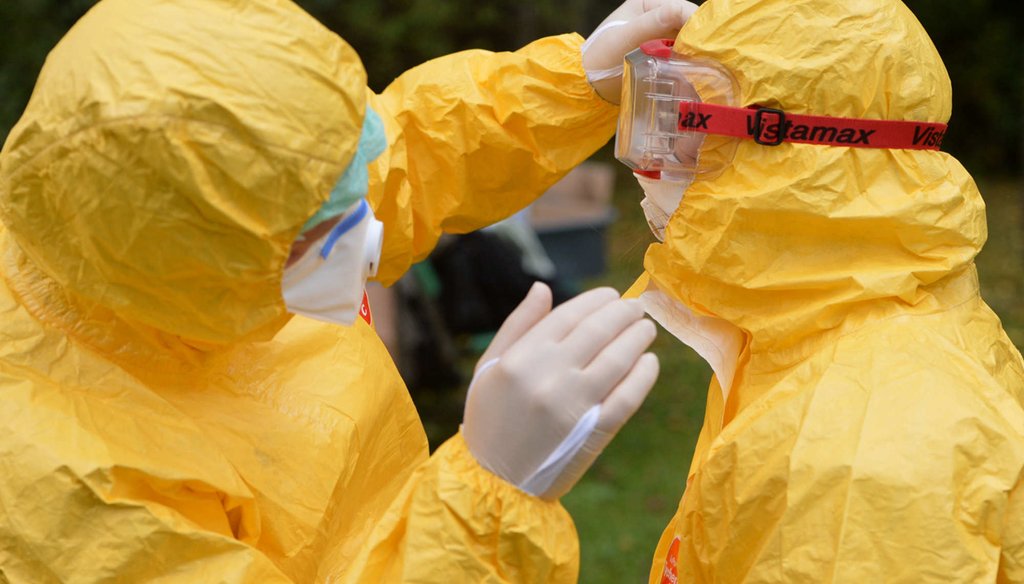Stand up for the facts!
Our only agenda is to publish the truth so you can be an informed participant in democracy.
We need your help.
I would like to contribute

The deadliness of Ebola that has doctors like this one in Germany donning full body protection has spurred conspiracy theories in the United States. (Getty Images)
Ebola research is heavily dependent on NIH funding -- but is it so dependent that the organization’s budget cuts have put vaccine development on the back burner?
Not surprisingly, the fight against Ebola in the United States has politicians pointing fingers -- with both parties blaming the other for unpreparedness and insufficient funding for the country’s public health programs.
National Institutes of Health Director Dr. Francis Collins threw his hat in the ring when he commented about the effect of budget cuts on Ebola research.
"Frankly, if we had not gone through our 10-year slide in research support, we probably would have had a vaccine in time for this that would've gone through clinical trials and would have been ready," Collins said in an Oct. 12 interview with Huffington Post.
The NIH is the world’s largest source of medical research funding. They conduct their own research, and they dole out competitive grants to universities and medical research companies.
Their budget has tightened over the past decade, especially following the recession and the 2013 sequester, the 10-year, across-the-board cuts that went into effect after Congress didn’t reach a budget compromise. We’ve found that both Republicans and Democrats (and both Congress and President Barack Obama) played a role in passing the sequester.
There’s no way to know what would have happened if the NIH hadn’t lost funding over the past 10 years. Nor can we predict how long it would take a particular drug to make it through the various phases of research and development, so we can’t put this claim on the Truth-o-Meter. We can, though, lay out as much as we do know about how much Ebola research has been restricted.
We found that Ebola research -- like many other projects -- has been subject to less available funding and wavering government priorities, meaning some research has been put on the shelf. If those projects had been able to get their full funding, it’s possible they would have been ready before the current outbreak.
Funding is certainly not the only factor affecting the speed of vaccine research, but it has played a part.
"With this Ebola crisis, a lot of our earlier decisions are coming home to roost," said Dr. Alan Cross, a professor at the University of Maryland School of Medicine’s Center for Vaccine Development.
The 10-year cuts
NIH’s overall budget grew modestly over the first half of the last decade -- from $28 billion in 2004 to about $30.5 billion in 2009. Then, it slipped down to about $29.3 billion in 2013.
The portion of that funding that goes toward the National Institute of Allergy and Infectious Diseases, which researches Ebola vaccines, followed a similar pattern -- from $4.3 billion in 2004, to $4.7 billion in 2009, and then back down to $4.3 billion in 2013.
These numbers do not take into account inflation, or rising costs and needs. The NIH budget grew nearly every year up until to 2009. (Between 1994 and 2004, there were some years the budget grew by almost $3 billion.)
The constricting budget’s effect on research is visible in grant application success rates. To receive NIH funding, researchers have to apply for grants, and the process is competitive. Success rates have gone down dramatically over the past 10 years, meaning fewer researchers are able to move forward with their projects.
Here's some data about research project grants -- the most commonly used NIH grant -- from the NIH Data Book.
Year
Grant app. success rate
# successful applicants
Grant awards (in billions)
2004
24.6 percent
10,052
$14.7
2005
22.3 percent
9,599
$15
2006
20 percent
9,128
$14.9
2007
21.3 percent
10,100
$15
2008
21.8 percent
9,460
$15
2009
20.6 percent
8,881
$15.4
2010
20.6 percent
9,455
$15.9
2011
17.7 percent
8,765
$15.8
2012
17.6 percent
9,032
$15.9
2013
16.8 percent
8,310
$14.9
Clearly the biggest drop was in 2013 -- following the sequester, which forced the NIH to shrink their budget by about 5 percent.
We should note that the NIH has only recorded how much its spending on particular research areas since 2010. Vox found a small decline in spending on Ebola research after 2010, to about $100 million. It dropped to $96 million after the sequester. However, the data to compare this to 2009 and earlier isn't available.
The toll on Ebola research
Ebola research got a big boost in the early 2000s. Following the anthrax scare, the government put a lot of funding toward biodefense research, with the intention of protecting against dangerous pathogens like anthrax, smallpox and Ebola.
But since that initial boost in the early 2000s, funding has waned, priorities have changed and research slowed.
"A lot of new projects were started then, and a lot of new science was generated," Cross said. "A lot of that has not progressed rapidly in recent years."
Dr. Annie De Groot -- who founded and runs a small vaccine company that has researched Ebola vaccines -- said the government will change its mind about what vaccines it wants at a certain time, which affects which grant applications are going to be the most competitive at the NIH.
For example -- her company, EpiVax, had been working with the government on a vaccine for Tularemia (also known as Rabbit Fever) for biodefense purposes since about 2003. They had great success with the vaccine on rodents, but then they were unable to get the funding that would have helped them test and develop a full-fledged product.
"All of a sudden they don’t want it any more after working on it for years," De Groot said.
She added that the lower grant success rate disincentivizes researches to pursue research that doesn’t fit the government’s priorities or runs the risk of failure.
Of course, now, Ebola vaccine and therapy research is a high priority, and some near-finished products have been fast-tracked -- like the ZMapp drug used to treat two American missionaries who contracted Ebola overseas. (ZMapp has yet to be produced in large enough quantities to treat people in Africa.) In September, the NIH started human trials on an Ebola vaccine that was in development.
Experts noted that these stages -- human trials and pharmaceutical production -- are often the most expensive parts of research, and clinical trials often fail. As a result, this is where a lot of research -- successful up to that point -- gets tabled, particularly if it isn’t of high priority.
Additionally, conducting Ebola research is especially difficult and expensive because only a few facilities are fully equipped to handle it at a certain phase, Cross said. Those labs need to be Biosafety Level 4 -- the highest biosafety designation -- because it’s such a dangerous disease with no widely available therapy. According to the Federation of American Scientists, there are only about a dozen BSL-4 labs in the United States.
What about the big pharmaceutical manufacturers? Turns out they don’t necessarily pick up the slack when NIH funding is tight.
Major pharmaceutical companies want to make drugs that are going to make money, but the highest demand for Ebola drugs is in low-income countries that don’t have buy the most vaccines, said Alexandra Stewart, a professor at the Milken Institute School of Public Health at the George Washington University.
The U.S. government, on the other hand, needs Ebola drugs as a matter of biodefense and public safety, so they end up being the primary financiers.
Some advocates of further budget cuts for government agencies (such as Sen. Rand Paul, R-Ky.) have criticized the NIH for not spending its money expediently. Rand, for example, pointed to NIH research grants for an "origami condom."
David Sanders, a Purdue University professor who has studied Ebola vaccines, said many of these critics are not in a position to judge those researchers, who go through the same vigorous application process as everyone else. The research might seem unimportant, but it could have major value years from now.
"A lot of the work that seems obscure -- just reading it out of context makes people think it’s not worth doing," Sanders said. "These things are peer-reviewed, and people find them important."
Our Sources
Huffington Post, "Ebola Vaccine Would Likely Have Been Found By Now If Not For Budget Cuts: NIH Director," Oct. 12, 2014
NIH, "FY2013 By The Numbers: Research Applications, Funding, and Awards," Jan. 10, 2014
NIH, Almanac: Appropriations, accessed Oct. 15, 2014
NIH, Databook, accessed Oct. 15, 2014
Vox, "We have the science to build an Ebola vaccine. So why hasn't it happened?" July 31, 2014
Vox, "No, budget cuts aren't the reason we don't have an Ebola vaccine," Oct. 16, 2014
Washington Post, "The absurd claim that only Republicans are to blame for cuts to Ebola research," Oct. 15, 2014
Washington Post, "Small drugmakers try to scale up to meet Ebola crisis," Oct. 9, 2014
New York Times, "Debate Over Ebola Turns to Specific Policy Requests," Oct. 13, 2014
The Hill, "Rand Paul mocks the NIH," Oct. 15, 2014
CBS, "Ebola Vaccine Being Tested in Rapid Fashion," Oct. 9, 2014
Interview, Annie De Groot, founder and CEO of EpiVax, Oct. 14, 2014
Interview, David Sanders, biology professor at Purdue University, Oct. 14, 2014
Interview, Alan Cross, professor at the UMD School of Medicine, Oct. 16, 2014
Email interview, Alexandra Stewart, public health professor at the George Washington University, Oct. 16, 2014
















































